Table of Contents
Guide
Pages
If you are an Annies customer and have a question about the instructions on a pattern you have purchased, please visit: http://www.anniescatalog.com/pages/customer_care/pattern_services.html
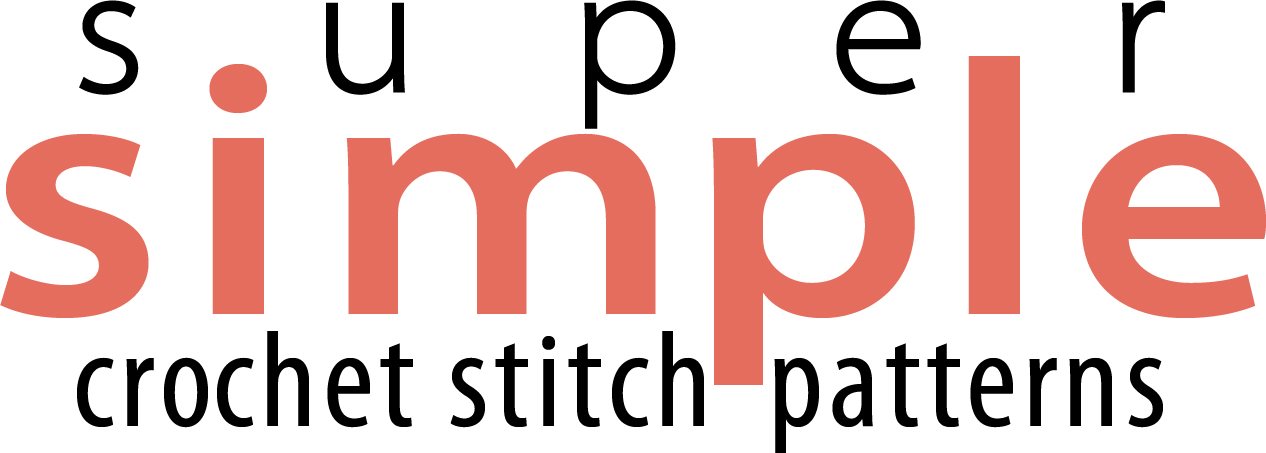
introduction
Twelve lovely designs created with short, simple repeats using basic stitches. Repeating eight stitches or less, these patterns create textures that look significantly more intricate than they are. Most repeat the same row for the entirety of the piece, giving the same look on both sides. The few that alternate a design row with a row of single crochets still keep it easy to tell what row is being worked and offer a slightly different look on each side, yet are still fully reversible. Instructions are included for many great projects that can be made with these simple yet elegant textures. Use the Project Instructions on for details on how to use the Project Box.
Check out the Did You Know section for information to improve your technique. Detailed photographs are provided throughout to make it even easier to stay on track and turn simple stitches into beautiful textures.
contents
Short, Simple Repeats Using Basic Stitches


Each pattern can easily be adapted for a wide variety of projects by changing the length of the starting chain and the number of rows worked. The Stitch Patterns
(. Each Stitch Pattern has a Project Box (like the example on this page) that provides starting chain lengths and other information needed for each project, along with instructions to make a custom size for your own projects. Note: Not all Projects are listed for every Stitch Pattern (Patterns with holes dont work well for Slippers, etc.).Skill Level: Easy
Hook Size: Suggested hook size listed in Project Box.
Note:Different Stitch Patterns may recommend a different hook size than other Stitch Patterns for the same Project.Materials: Yarn requirements: Listed in the Project Box.
Note:Different Stitch Patterns may recommend a different hook size than other Stitch Patterns for the same Project.Materials: Yarn requirements: Listed in the Project Box.
Tapestry needle: For weaving in ends after fastening off. Gauge: I/9/5.5mm hook: Gauge swatch (see ) is 31/2 inches x 3 inches. Project Gauge: Check Row 1 against measurement in Project Box. Stitches Used: Ch, sl st, sc, dc, tr. 
Tips & Techniques to Improve Your Crochet
How to Get the Gauge Gauge Swatch Use this swatch to check against gauge used for sizing in this book.
(10 sc)Rows 210 : Ch 1, sc in each st across.
(10 sc)Rows 210 : Ch 1, sc in each st across.
This swatch measures 3 inches 3 inches.  Why Gauge Is Important Having the same gauge as the instructions is important in getting the same size finished piece as the instructions are intended for. This is especially important for garment sizing and for yarn requirements. A garment will not fit the size intended if not crocheted in the gauge specified in the instructions. A project crocheted with a larger gauge will turn out larger than the size intended and will require more yarn to complete than the instructions call for. The Stitch Patterns in this book are easily adapted if youre having trouble matching the gauge swatch.
Why Gauge Is Important Having the same gauge as the instructions is important in getting the same size finished piece as the instructions are intended for. This is especially important for garment sizing and for yarn requirements. A garment will not fit the size intended if not crocheted in the gauge specified in the instructions. A project crocheted with a larger gauge will turn out larger than the size intended and will require more yarn to complete than the instructions call for. The Stitch Patterns in this book are easily adapted if youre having trouble matching the gauge swatch.
If Your Swatch Is Larger Try making the gauge swatch again with a smaller hook. If you are still having trouble getting the gauge, then decrease the starting chain length per the instructions at the bottom of the Project Box (see General Information on . To get the correct height of the piece, rows may need to be subtracted. If Your Swatch Is Smaller Try making the gauge swatch again with a larger hook. If you are still having trouble getting the gauge, then increase the starting chain length per the instructions at the bottom of the Project Box. If needed, add rows to get the correct height measurement of the piece. If Your Swatch Now Has the Right Gauge But Looks Like It Has Holes This occurs when the tension on the yarn is very tight.
The test swatch (below right) needed an N/13/9mm hook to get the width of the gauge swatch that used an I hook. Notice how it looks like there are holes between the single crochets.  For projects in this book, the finished size of the piece prior to assembly is important for sizing (not the number of stitches in the starting chain or number of rows used). Use the hook size needed to obtain gauge and work the Stitch Patterns as instructed with the starting chain and end row listed in the Project Box. Or use the hook size that is comfortable and adjust the length of the starting chain per the instructions at the bottom of the Project Box. Adjust the end row to get the needed measurements for the piece.
For projects in this book, the finished size of the piece prior to assembly is important for sizing (not the number of stitches in the starting chain or number of rows used). Use the hook size needed to obtain gauge and work the Stitch Patterns as instructed with the starting chain and end row listed in the Project Box. Or use the hook size that is comfortable and adjust the length of the starting chain per the instructions at the bottom of the Project Box. Adjust the end row to get the needed measurements for the piece.
Experimenting With Size Hook Size Yarn manufacturers often put a recommended hook size on the yarn label. The worsted-weight yarn used in this book has a recommended hook size of I/9/5.5mm. In the Project Box included with each Stitch Pattern there is a column for hook and a column for yarn requirements. Not all projects that use worsted-weight yarn use an I hook. That is because different effects can be obtained with different sizes of hooks.  K hook swatchback I hook swatchmiddle G hook swatchfront Using a smaller hook makes the stitching tighter, and more stitches will be needed to get the same measurements of a piece worked with a larger hook.
K hook swatchback I hook swatchmiddle G hook swatchfront Using a smaller hook makes the stitching tighter, and more stitches will be needed to get the same measurements of a piece worked with a larger hook.  K hook swatchback I hook swatchmiddle G hook swatchfront Using a smaller hook makes the stitching tighter, and more stitches will be needed to get the same measurements of a piece worked with a larger hook.
K hook swatchback I hook swatchmiddle G hook swatchfront Using a smaller hook makes the stitching tighter, and more stitches will be needed to get the same measurements of a piece worked with a larger hook.
Ripples () are stitched mostly with double crochets and thus have more stretch than the other Stitch Patterns. Using a smaller hook when making a large project like the Afghan or Lapghan will have the effect of tighter stitching for these Stitch Patterns. Using a larger hook makes the stitching looser, or more airy, and can be desirable in a project like the Cowl or to make an afghan fluffier. When experimenting with hook size, measure Row 1 to make sure its the desired size. Work the number of rows needed to get the desired height for the piece. Yarn Size Worsted-weight yarn is a versatile yarn for many projects.

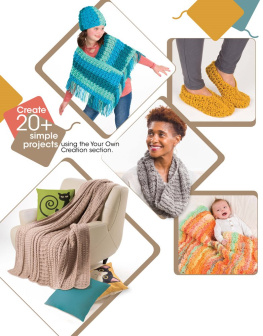
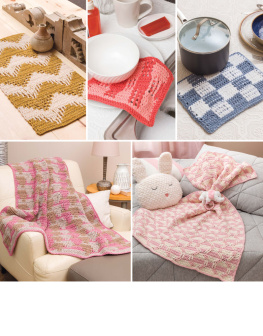


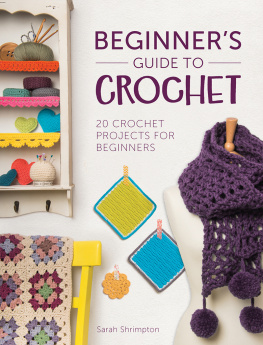
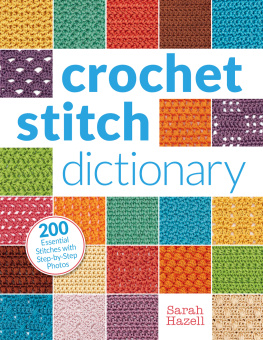

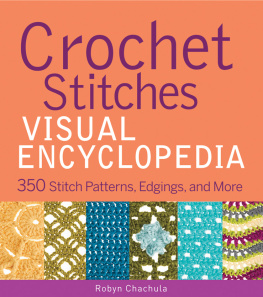
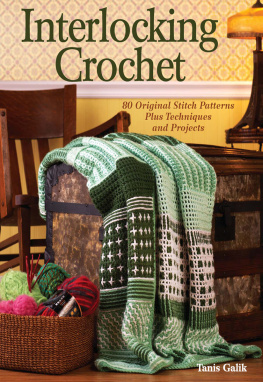
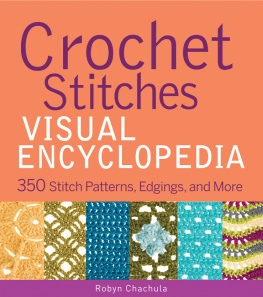





 Why Gauge Is Important Having the same gauge as the instructions is important in getting the same size finished piece as the instructions are intended for. This is especially important for garment sizing and for yarn requirements. A garment will not fit the size intended if not crocheted in the gauge specified in the instructions. A project crocheted with a larger gauge will turn out larger than the size intended and will require more yarn to complete than the instructions call for. The Stitch Patterns in this book are easily adapted if youre having trouble matching the gauge swatch.
Why Gauge Is Important Having the same gauge as the instructions is important in getting the same size finished piece as the instructions are intended for. This is especially important for garment sizing and for yarn requirements. A garment will not fit the size intended if not crocheted in the gauge specified in the instructions. A project crocheted with a larger gauge will turn out larger than the size intended and will require more yarn to complete than the instructions call for. The Stitch Patterns in this book are easily adapted if youre having trouble matching the gauge swatch. For projects in this book, the finished size of the piece prior to assembly is important for sizing (not the number of stitches in the starting chain or number of rows used). Use the hook size needed to obtain gauge and work the Stitch Patterns as instructed with the starting chain and end row listed in the Project Box. Or use the hook size that is comfortable and adjust the length of the starting chain per the instructions at the bottom of the Project Box. Adjust the end row to get the needed measurements for the piece.
For projects in this book, the finished size of the piece prior to assembly is important for sizing (not the number of stitches in the starting chain or number of rows used). Use the hook size needed to obtain gauge and work the Stitch Patterns as instructed with the starting chain and end row listed in the Project Box. Or use the hook size that is comfortable and adjust the length of the starting chain per the instructions at the bottom of the Project Box. Adjust the end row to get the needed measurements for the piece. K hook swatchback I hook swatchmiddle G hook swatchfront Using a smaller hook makes the stitching tighter, and more stitches will be needed to get the same measurements of a piece worked with a larger hook.
K hook swatchback I hook swatchmiddle G hook swatchfront Using a smaller hook makes the stitching tighter, and more stitches will be needed to get the same measurements of a piece worked with a larger hook.